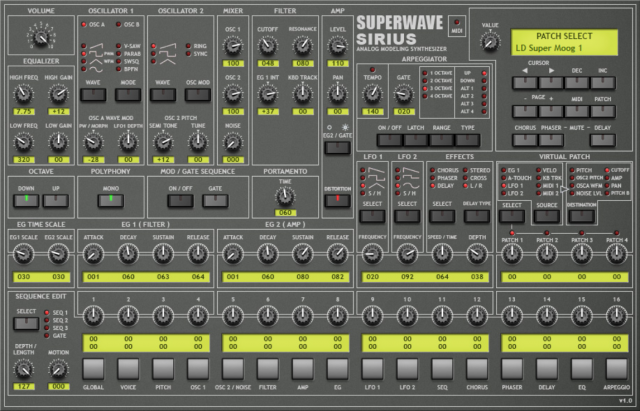
SuperWave has introdcuced SuperWave Sirius, a new virtual analog synthesizer for Windows that features a Moog-inspired filter.
Here’s what they have to say about Sirius:
If you’re looking for a synthesizer capable of huge leads, pads, strings and basses, then you must check out the Sirius.
The Sirius features much of the technology used in the Tarkus synthesizer, but has a Moog 4-Pole 24dB Filter instead of a State Variable Filter. In short, think of the Sirius as a Mini Moog Synthesizer using the Korg MS2000 Block diagram for the sound structure.
The Sirius features four sixteen step Sequencers, Arpeggiator and Multi-Effects which include Chorus, Phaser, Delay, Distortion and EQ.
If you’re lucky enough to own a Korg MS2000, then you can use the MS2000’s control surface to edit most of the Sirius’s common control parameters.
SuperWave is available for £14.99. A demo version is also available.

This is different from Tarkus how ?
p://www.superwavesynths.co.uk/images/screenshot_tarkus.jpg
“The Sirius features much of the technology used in the Tarkus synthesizer, but has a Moog 4-Pole 24dB Filter instead of a State Variable Filter.”
from product description linked right in the article
Maybe moog inspired filter… But I would say a Virus inspired ui!
Not a Virus inspired UI, Korg MS2000BR inspired UI.
Looks like some freeware MS-2000 editor from 2003 was repurposed.
Also, the editor is calling and it wants its UI back. But while it was calling, it got another call, this one was from 2001 and it was asking 2003 freeware for ITS UI back.
It looks like an MS2000, because it is designed so that you can use an MS200o as a controller for this soft synth. Says that in the article, you didn’t read….
Be sort of hard to do that if the editor and synth panel were really different looking.
any further info on just how much control the ms2000 can achieve? it sais most params, their site dosent give anymore info.
Too bad there is no x64 or OSX support. Synthedit really needs an update.
Synthedit can make x64 plugins, but you must only use x64 modules inside your project. If you use even one x86 32 bit module your project will not be x64. The problem is most 3rd party modules are x86 and have been abandonned and will never be updated.
There is someone else from the 90’s calling on the other line, it’s Quasimidi, they want their Sirius back.
I had the Quasimidi Sirius and the Korg ms2000. Guess which one I wish I had back.
But looks like a MS2000
I appreciate the basic layout, the mod routings and the (surely) reasonably stout sound. It looks like a solid synth I might play if I needed a VA. However, would I seem like an elitist heel if I said there were already dozens and dozens of VERY similar synths to be had? I can easily grasp why someone might even like 3 or 4 VAs/real analogs because ANALOG. I gladly get it. A Moog sounds different than a Synthex and you have a right to decide which range of colors suits you best. The flip side, though, is getting into each synth you own deeply enough to really use and thus justify the creative sweat, as well as the system load it can represent. Would this be better than a U-he Zebra? Not if you want a bigger mod routing list and the means to draw your own waveforms. If you want that particular Korg shaping, at first review, it looks pretty nicely empowered, especially with the Moog-ish intent. I’ll offer another positive: it feels partly like a Korg Mono/Poly I had for a while. You could stack the voices or use them as a 4-voice synth. It would thin out a bit much as a poly, but this instrument won’t have that issue.
Tarkus sounds better than the Korg MS2000
..
Sirius sounds WAY better than the Korg MS2000
Most things sound better than an MS2000. But the sequencer part is fun!